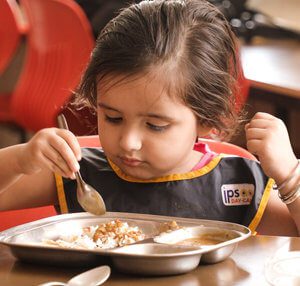One of the worst meal time challenges parents might face with your toddler is that my child doesn’t chew the food or my child doesn’t know how to chew food. She might refuse to chew, keeping the food as it is in her mouth(pocketing food) & it takes hours or sometimes your whole day!
A power struggle ensues between the two of you, and in an attempt to get her to eat, you force her. She, in turn, wants to get done with the ordeal and swallows the food. The result is the food is not digested properly and she throws up entire meal, or, well, just passes it out as stool without being digested. Isn’t true with your child?
Either way, it isn’t healthy for your child. Read on to find out more about toddlers and chewing, and what you can do to help.
At What Age Do Children Start Chewing Food?
Like any other new skill, yes eating is also a life skill, chewing depends on various experiences and skills that your baby has picked up in the previous months.
Chewing may start around 6-9 months. This time period is a critical window of opportunity to start with the introduction of textured food (pureed, textured foods).
Feels like your baby is putting everything in her mouth? Great. Use this opportunity to give her different textures and types of food, so she can effectively use the jaws, tongue and cheeks.

Drinking from a straw strengthens oral and speech development .
After one year of age, kids who continually thrust their tongue forward to swallow, which happens with prolonged sippy cup usage, have difficulty acquiring speech sounds along with chewing and swallowing a variety of food textures.
Drinking from a straw, specifically from a small straw, allows the tongue tip to rise up and press the alveolar ridge for developing the proper swallowing patterns. Straw builds oral motor strength and stability for talking and chewing more advanced foods.
Late introduction of textured food may lead to problems in chewing for your toddler. By 10 months your baby should be given mashed foods to encourage chewing.
Why Chewing Food Is A Challenge In Toddlers?
Here are some common reasons why chewing turns into a problem with toddlers:
1. Late introduction of solids: A possible reason is the late introduction of solids (later than 6-8 months), in your baby’s diet.
In such a case, optimal development of motor skills such as chewing could be delayed
2. Your baby can have trouble accepting a new texture, which can be solids/semi-solids according to age transition in place of the preferred texture, which is liquid milk
3. Late introduction of textured foods: (most important)Again, a baby who has not been introduced to textured and coarse foods (like khichri, porridge) by 8-10 months (when she starts to sit by herself) will have a problem in chewing foods later (at 14-15 months of age)
4. Disinterest in food: Another reason for not chewing in toddlers could be simple disinterest in the food.
This could be because of lack of variety in terms of taste, texture, or flavor. If a toddler is given same food (rice/chapatti/any other staple) every day for all three meals, she may be bored and refuse to chew the food.
What Can I Do To Make My Toddler Chew Food Rather Than Gobble Up ?
Here are some tips you can follow to help your toddler chew her food:
Gradual introduction of textured or coarse food: Introduce foods with texture very slowly to your baby. You can use a baby food mill/hand blender to create a very soft, gentle texture.
1. You can give your toddler the familiar pureed food (blended khichri, dalia, upma) and then offer a small spoonful of the textured food (spoon mashed or hand mashed foods), mixed in with the familiar puree. Then offer a spoonful of the pureed food
2. Gradually, you can offer several spoons of the textured food and follow it with several spoons of pureed food. As your baby becomes accustomed to the new texture, she will be able to eat just the textured foods.
Introduce new foods to your baby after offering enough of a familiar food or texture when she is not extremely hungry. Small portion your choice and large portion of his choice.
3. Move slowly as you increase the texture and the challenge for your baby. Let your baby guide you. If she has difficulty with the amount of lumpiness or the size of the pieces in the food, go back to an easier food mixture that she handled successfully earlier
4. When she is doing well with the food you have served, begin to make the pieces of food bigger or include several different types of pieces in the textured-food meal
Family meal times: Try and make your child have meals with the family. You can make your child sit in a comfortable chair along with other family members for the meal times. This would encourage her to start with chewing solids. Show her that everyone is chewing the food.
Learning by imitation: Children also follow each other. Seeing other children eat solid food would also encourage her to chew. You may sometimes invite over some neighbors, friends or cousins of the same age group to encourage your child.
Space meals out properly: Keep appropriate gap to ensure hunger, at least 2-3 hours, between meals. Allocate fixed time for meals. Your child should finish her main meals in 20-25 minutes and for snacks give 10-15 minutes’ time to finish. If your child takes longer than that remove the plate. Over a period of time, your child would start finishing her meals on time.
What To Do When Your Toddler Gets Bored Of Eating Same Food?
Now, your toddler could be losing interest or may be bored of eating the same type of food. So, they tend to keep the food in the mouth instead of chewing it. In that case, you may try the following tips.
1. Present food with rainbow colors (add different colored vegetables)
2. Try to cook the foods s/he dislikes in different ways to make them interesting. Broccoli cakes, broccoli paratha, broccoli and cheese with chicken or sautéed in butter.
3. Try changing texture of the food which your child doesn’t like.
4. Offer finger foods like boiled carrot sticks once in a day; you can use ice tray for the same. Let her/him mess around. Toddlers sometimes like to explore. That’s how they learn.
5. Eat the same food (that s/he dislikes) with him/her. Look interested and praise the food. Toddlers like to follow their parents. If s/he still refuses the same food, avoid offering them to her/him for a few days, and then try again by cooking in a different way.
Your job is to offer healthy food and your child’s job is how to eat and what to eat.
If your child faces the same challenge do share your concerns in the comments, would be happy to help you.
Happy Feeding!


